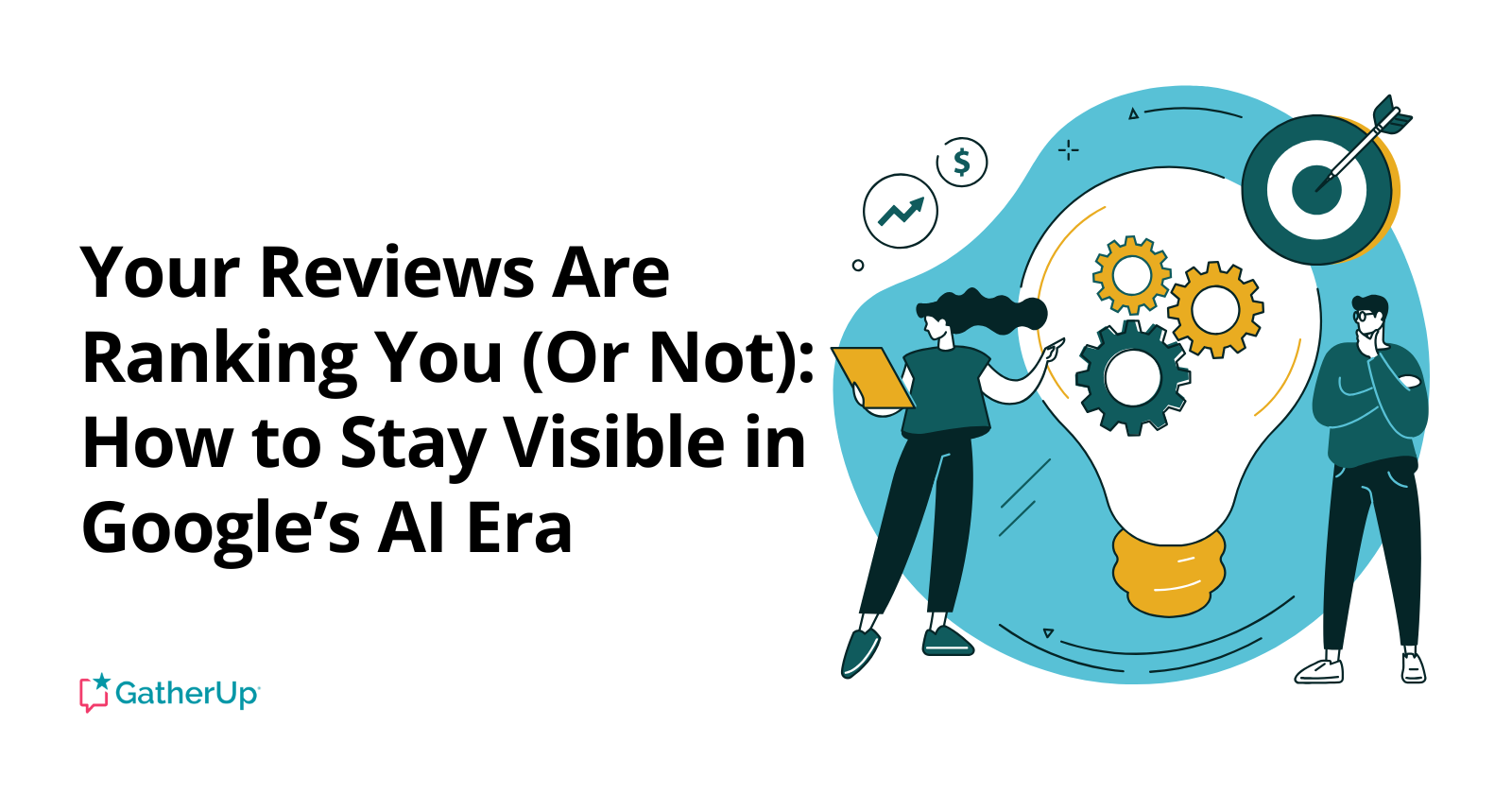This post was sponsored by GatherUp. The opinions expressed in this article are the sponsor’s own.
If your business has a great local, word-of-mouth reputation but very few online reviews, does it even exist?
That’s the existential riddle facing local businesses and agencies in 2025.
With Google’s AI Overviews (AIOs) now reshaping the search experience, visibility isn’t just about being “the best.”
It’s about being part of the summary.
And reviews? They’re no longer just trust signals. They’re ranking signals.
In This Article
This article breaks down what’s changing, what’s working, and how agencies can keep their clients visible across both traditional local search and Google’s evolving AI layer.
Reviews Are Now A Gateway To Search Inclusion
Reviews have long been seen as conversion tools, helping users decide between businesses they’ve already discovered. But that role is evolving.
In the era of Google’s AI Overviews (AIOs), reviews are increasingly acting as discovery signals, helping determine which businesses get included in the first place.
GatherUp’s 2024 Online Reputation Benchmark Report shows that businesses with consistent, multi-channel review strategies, especially those generating both first- and third-party reviews, saw stronger reputation signals across volume, recency, and engagement. These are the exact kinds of signals that Google’s systems now appear to prioritize in AI-generated results.
That observation is reinforced by recent industry research and leaked Google documentation, which suggest that review characteristics like click-throughs, content depth, and freshness contribute to both local pack visibility and AIO inclusion.
In other words, the businesses getting summarized at the top of the SERP aren’t just highly rated. They’re actively reviewed, broadly cited, and seen as credible across sources Google trusts.
Recency Is A Signal. “Relevance” Is Google’s Shortcut.
More than two-thirds of consumers say they prioritize recent reviews when evaluating a business. But Google doesn’t necessarily show them first.
Instead, Google’s “Most Relevant” filter may prioritize older reviews that match query terms, even if they no longer reflect the current customer experience.
That’s why it’s critical for businesses to maintain steady review velocity. A flood of reviews in January followed by silence for six months won’t cut it. The AI layer, and the human reader, needs signals that say “this business is active and trustworthy right now.”
For agencies, this presents an opportunity to shift client mindset from static review goals to ongoing review strategies.
Star Ratings Still Matter, But Mostly As A Decision Shortcut
During our recent webinar with Search Engine Journal, we explored how consumers are using star ratings to disqualify options, not differentiate them.
Research shows:
- 73% of consumers won’t consider businesses with fewer than 4 stars
- But 69% are still open to doing business with brands that fall short of a perfect 5.0, so long as the reviews are recent and authentic
In other words, people are looking for a “safe” choice, not a flawless one.
A few solid 4-star reviews with real detail from the past week often carry more weight than a dozen perfect ratings from 2021.
Agencies should help clients understand this nuance, especially those who are hesitant to request reviews out of fear of imperfection.
First-Party & Third-Party Reviews: Both Are Necessary
AI Overviews aggregate information from across the web, including structured data from your own website and unstructured commentary from others.
- First-party reviews: These are collected and hosted directly on the business’s website. They can be marked up with schema, giving Google structured, machine-readable content to use in summaries and answer boxes.
- Third-party reviews: These appear on platforms like Google, Yelp, Facebook, TripAdvisor, and Reddit. They’re often seen as more objective and are more frequently cited in AI Overviews.
Businesses that show up consistently across both types are more likely to be included in AIOs, and appear trustworthy to users.
GatherUp supports multi-source review generation, schema markup for first-party feedback, and rotating requests across platforms. This makes it easier for agencies to build a review presence that supports both local SEO and AIO visibility.
AIOs Pull From More Than Just Google Reviews
According to recent data from Whitespark, over 60% of citations in AI Overviews come from non-Google sources. This includes platforms like:
- Reddit.
- TripAdvisor.
- Yelp.
- Local blogs and industry-specific directories.
If your client’s reviews live only on Google, they risk being overlooked entirely.
Google’s AI is scanning for what it deems “experience-based” content, unfiltered, authentic commentary from real people. And it prefers to cross-reference multiple sources to confirm credibility.
Agencies should encourage clients to broaden their review footprint and seek mentions in trusted third-party spaces. Dynamic review flows, QR codes, and conditional links can help diversify requests without overburdening the customer.
Responses Influence Visibility & Build Trust
Review responses are no longer just a nice gesture. They’re part of the algorithmic picture.
GatherUp’s benchmark research shows:
- 92% of consumers say responding to reviews is now part of basic customer service.
- 73% will give a business a second chance if their complaint receives a thoughtful reply.
But there’s also a technical upside. When reviews are clicked, read, and expanded, they generate engagement signals that may impact local rankings. And if a business’s reply includes resolution details or helpful context, it increases the content depth of that listing.
For agencies juggling multiple clients, automation helps. GatherUp offers AI-powered suggested responses that retain brand tone and ensure timely replies, without sounding robotic.
How Agencies Can Make AIO Part Of Their Core Strategy
Google’s AI systems are designed to answer user questions directly, often without requiring a click. That means review content is increasingly shaping brand narratives within the SERP.
To adapt, agencies should align client visibility efforts across both search formats:
For Local Pack Optimization
- Keep Google Business Profile listings fully updated (photos, categories, Q&A).
- Build and maintain steady review velocity using email, SMS, and in-person requests.
- Respond to reviews regularly, especially nuanced or negative ones.
For AIO Inclusion
- Collect first-party reviews and mark them up with schema.
- Rotate requests to third-party platforms based on vertical relevance.
- Capture reviews with photo uploads and detailed descriptions.
- Build unstructured citations through community involvement, media mentions, and event participation.
Download Our Complete Proactive Reputation Management Playbook for Digital Agencies for templates and workflows to operationalize this as a branded, revenue-generating service.
Reputation Is No Longer Separate From Rankings
AI Overviews now appear in nearly two-thirds of local business search queries. That means your clients’ next customers may form an impression—or make a decision—before ever clicking through to a website or map pack listing.
Visibility is no longer guaranteed. It’s earned through content, coverage, and credibility.
And reviews sit at the center of all three.
For agencies, this is a moment of opportunity. You already have the tools to guide clients through the shift. You know how to structure content, build citations, and amplify voices that resonate with customers.
Reputation management isn’t optional anymore. It’s infrastructure.
About GatherUp
GatherUp is the only proactive reputation management platform purpose-built for digital agencies. We help you build, manage, and defend your clients’ online reputations.
GatherUp supports:
- First- and third-party review generation across multiple platforms,
- Schema-marked up feedback collection for AIO relevance,
- Intelligent, AI-assisted response workflows,
- Seamless white-labeling for full agency control,
- Scalable review operations tools that can help you manage 10 or 10,000 locations and clients.
Agencies who use GatherUp don’t just react to algorithm changes. They shape client visibility, and defend it.
To learn more, watch the full webinar for actionable strategies, data-backed insights, and examples of AIO-influenced local search in the wild.
Image Credits
Featured Image: Image by GatherUp. Used with permission.


